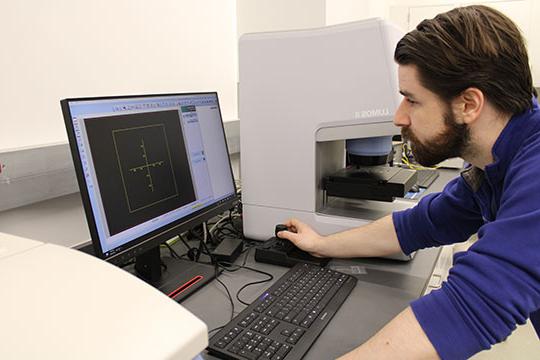Alfred University glass scientists pursuing method for washing wine bottles for reuse

Glass scientists at Alfred University, in a partnership with New York State and Vitricity, a consulting company focused on promoting sustainability in the glass industry, are studying ways to wash and reuse wine bottles. The project could remove tens of thousands of wine bottles from the waste stream each year while helping Finger Lakes Region wine producers realize significant savings.
The bottle washing research project, conducted at Alfred University’s Center for Glass Innovation, is supported by grant monies from the New York State Department of Environmental Conservation (DEC), with assistance from Vitricity, a company which conducts market research and serves as a consultant to businesses and organizations pursuing glass recycling/reuse initiatives.
The DEC has awarded Alfred University $4.2 million from its Environmental Protection Fund to perform research aimed at promoting glass recycling and reuse. The bottle washing project is supported by these grant funds.
“The citizens of New York State really care about sustainability in manufacturing. The DEC recognizes this and has taken a leadership role in projects that promote a circular economy, in which we take waste products and use them for something else,” said Collin Wilkinson, professor of glass science in Alfred University’s Inamori School of Engineering, who directs the Center for Glass Innovation. “The difficulty is finding ways to do that. Our job is to think about glass” and how it can be reused.
Rebecca Welch, PhD student in materials science and engineering at Pennsylvania State University who has served as visiting scholar and adjunct at Alfred University since last spring, is a researcher for Vitricity. Her work on the bottle washing project includes surveying wine producers in the region to gauge their interest in the project, and to provide education on its benefits in terms of sustainability.
There are more than 130 wineries in the Finger Lakes Region, primarily on Keuka, Seneca, and Cayuga lakes. Welch said according to surveys the region’s wine producers, the average winery uses about 10,000 bottles each year in their tasting rooms alone, with some going through as many as 50,000 annually. For the most part those bottles are not reused and likely end up in landfills. Developing an effective method of washing and reusing bottles could have a significant impact on sustainability efforts in the region’s wine industry. And with the cost of wine bottles increasing, due in large part to supply chain issues, there is an incentive for wineries to reuse their bottles.
“Our research shows that in some countries that have bottle washing, bottles can be used as many as 30 times. Canada has programs in place, focusing on the beer industry. We’d like to do what they’ve done and apply it to wineries in the Finger Lakes Region. This would be a huge benefit, not only for the vineyards financially, but for our overall sustainability efforts,” Welch commented.
“There are some concerns,” she noted. “How do we know the bottles are clean enough to be reused? What is the impact of water and the cleaning detergents: does it corrode the glass? How does wine impact the integrity of the glass? As the bottles are washed, how long before the glass breaks?”
Glass scientists at Alfred University aim to answer those questions. Arron Potter, a postdoctoral researcher in the Center for Glass Innovation, is helping lead efforts to find effective ways to clean wine bottles.
The process comes with some challenges. Potter explained that glass is minutely porous—its pores are measured in nanometers, which equates to billionths of a meter. Liquid stored in bottles—in this case, wine—can degrade glass and settle under the surface of the inside of the bottle. That residue is evident in its odor and potentially could impact the taste of the wine. He compared the effect wine has on a bottle to that which pickles have on a jar.
“You can wash a pickle jar several times and the smell of the pickles will remain,” Potter said. “The same thing happens with wine bottles.”
Potter’s research is looking into a method of washing the bottle in which a very thin layer—as small as a micron, or one-millionth of a meter—of the glass surface is removed, taking away any residual moisture and leaving a new, more pristine interior surface of the bottle.
“The biggest challenge is knowing how much water is in the glass surface. It can be very difficult to measure,” Potter said, noting that researchers use infrared microscopy to determine how much water is in the surface of the bottle’s interior, and how far into the surface it is evident.
Welch said once a suitable method for washing the bottles is achieved, focus will be placed on developing facilities for collecting and washing the bottles and determining how they will be transported to and from the wineries.
“We need to make washing and reusing bottles cheaper or the same as buying new,” Welch said, noting that the state may consider providing subsidies to wineries as an incentive to reuse bottles. “I feel we can meet the current cost without subsidies. With government support, it would be cheaper” to reuse bottles.
Alfred University and Vitricity will hold a banquet event on May 8 at Barrelhouse 6 Distillery near Hammondsport, NY—of which Alfred University alumna Kara Mackey ’88 is co-founder and managing director—to provide information to winery/vineyard owners and local businesses on the status of the project and how it could benefit their businesses and improve sustainability. Project organizers hope after the event they will have a better idea how many wineries are on board with the idea.
“We want to help this program succeed by spreading awareness and educating the vineyards about the program,” Welch said. “Most (wine producers) who answered our survey said they were concerned about the environment and want to make the Finger Lakes Region more sustainable. Sustainability is at the core of a lot of their business models.”
